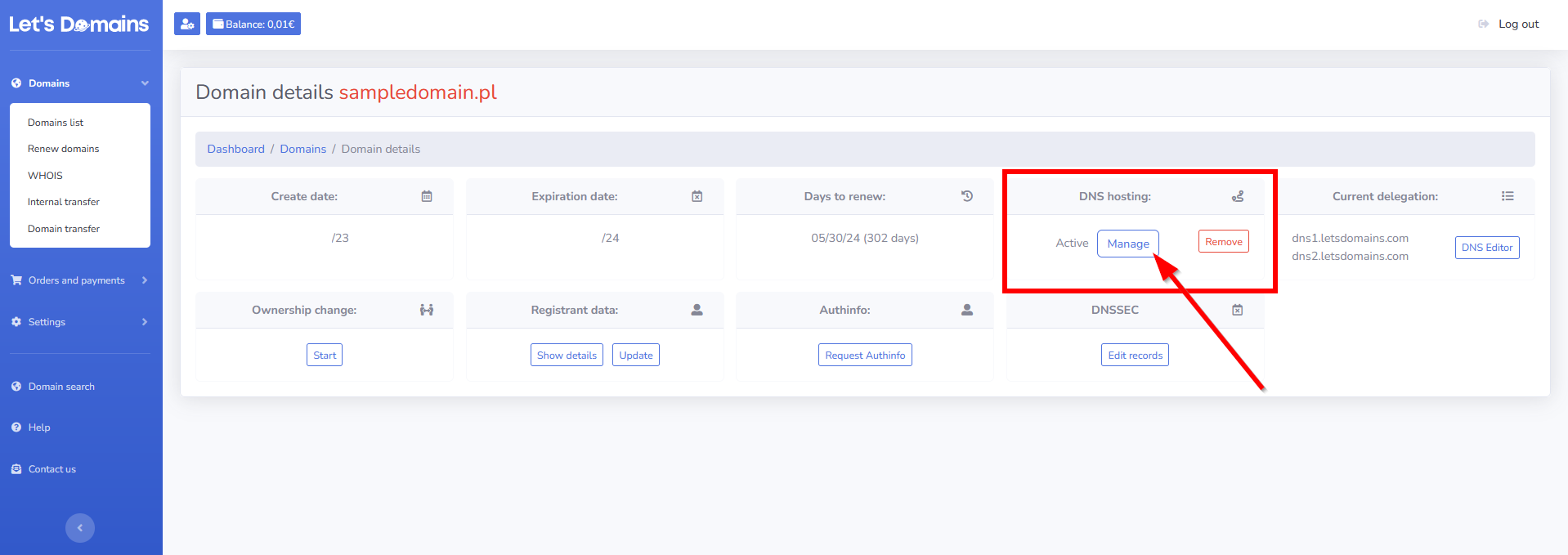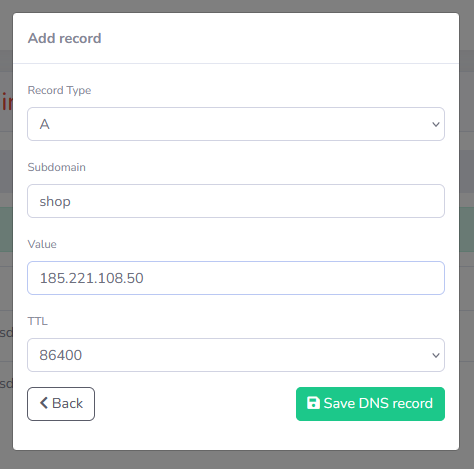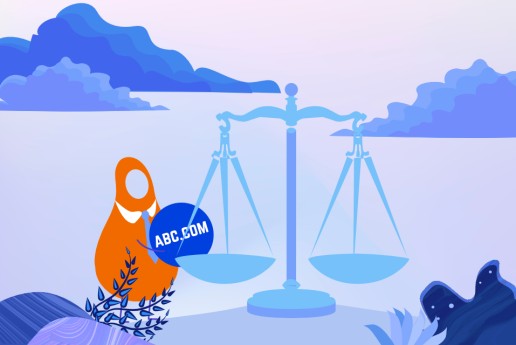Ce este un subdomeniu? Definiția noastră, exemple și metode de utilizare

La începutul aventurii tale cu domeniile, multe concepte sunt noi și adesea incomprehensibile. Te întrebi ce este un subdomeniu și cum poate afecta prezența ta online? Dacă da, ești în locul potrivit!
În acest articol, vom explica într-un mod prietenos și accesibil ce este un subdomeniu, cum funcționează și cum îl poți folosi. Fie că ești un începător în lumea Internetului sau un webmaster experimentat, cu siguranță vei găsi ceva aici pentru tine.
Ce este un subdomeniu?
Un subdomeniu include numele domeniului tău. Un subdomeniu este, de asemenea, o parte a domeniului principal care îți permite să îți organizezi site-ul. Poate fi comparat cu o diviziune suplimentară pe site-ul tău care îți permite să îți organizezi mai bine conținutul.
De exemplu, domeniul nostru principal este "letsdomains.com", așa că putem crea un subdomeniu numit "blog.letsdomains.com". Acest subdomeniu poate fi folosit pentru a găzdui blogul nostru, în timp ce domeniul principal este folosit pentru a găzdui pagina noastră de start cu un căutător de domenii.
Poți face același lucru cu site-ul tău. În subdomeniul blog.yourwebsite.com, poți întreține un blog pentru a completa magazinul tău. Apoi, în subdomeniul store.yourwebsite.com, poți rula magazinul tău online.

De ce să folosești un subdomeniu?
Te întrebi de ce să folosești un subdomeniu? Subdomeniile sunt incredibil de utile atunci când vrei să creezi secțiuni separate pe site-ul tău care au funcții unice. De exemplu, multe companii folosesc subdomenii pentru a crea magazine online, bloguri, forumuri și alte secțiuni pe site-ul lor.
Cu toate acestea, este important să reții că subdomeniile sunt tratate ca site-uri separate de motoarele de căutare, cum ar fi Google. Aceasta înseamnă că trebuie să optimizezi fiecare subdomeniu pentru SEO ca și cum ar fi un site separat. Sperăm că ți-am răspuns la întrebarea despre de ce să folosești un subdomeniu.
Structura URL a subdomeniului
O parte importantă a înțelegerii modului în care funcționează un subdomeniu este structura sa. Subdomeniul și domeniul încep ambele cu HTTP sau Protocolul de Transfer Hypertext. Acesta este responsabil pentru comunicarea între oricine tastează adresa site-ului tău și serverul pe care este încorporat site-ul tău.
O altă parte a unui URL de subdomeniu este subdomeniul WWW, care nu apare întotdeauna în adresele web. WWW este prescurtarea pentru World Wide Web și se referă la numele serverului și serviciul pe care l-a oferit. WWW se referă la site-uri web și înseamnă că un anumit server găzduiește (menține) informații. Abrevierea WWW apare în adrese în principal din cauza practicii de lungă durată și nu este necesară.
Următoarea parte a subdomeniului este doar numele său, de exemplu, blog, magazin, ofertă. Apoi, în ordinea adresei avem numele domeniului, de exemplu, letsdomains sau yourwebsite și după un alt punct vedem extensia, de exemplu, .com, .org, .net.
O adresă URL de subdomeniu este destul de lungă, iar un subdomeniu este unul dintre componentele acelei adrese. Acum știi de ce să folosești un subdomeniu și cum este structurată o adresă URL de subdomeniu. Dar care este diferența dintre un domeniu și un subdomeniu?

Domeniu vs subdomeniu
Când vine vorba de subdomenii, întâlnim adesea și termenul domeniu, iar deși aceste termeni se referă la o adresă de Internet, există în cele din urmă mai multe diferențe importante între ele:
-
Poziția în ierarhie. Înregistrarea domeniilor, începând cu extensiile, este împărțită pe niveluri. Un domeniu, cum ar fi yourwebsite.com, este un domeniu de nivel secundar. Prima linie este extensia .com, iar a doua linie este numele domeniului "yourwebsite." Un subdomeniu este fiecare nivel ulterior. Când creezi un site de blog, cum ar fi blog.yourwebsite.com, creezi un domeniu de nivel trei. În cazul subdomeniului en.blog.yourwebsite.com, creezi un domeniu de nivel patru.
-
Funcționalitate. De obicei, un domeniu este folosit pentru a oferi servicii sau produse cheie. Cu subdomeniile, oferi servicii sau produse suplimentare, sau cele în alte limbi. Adesea subdomeniile sunt folosite pentru a prezenta o versiune mobilă a site-ului, cum ar fi m.yourwebsite.com.
-
Gestionare. Poți gestiona domeniul doar cu registrarul (care este Let's Domains) cu care ai înregistrat domeniul. Poți gestiona un subdomeniu doar cu hostingul. Mai jos descriem cum să creezi un subdomeniu și unde poți gestiona domeniul tău.
-
SEO. Motoarele de căutare consideră domeniile și subdomeniile ca site-uri separate. Subdomeniul blog.yourwebsite.com este indexat și clasat independent de domeniul principal yourwebsite.com. Având în vedere aceste diferențe, tacticile SEO pentru un domeniu și un subdomeniu ar trebui să fie diferite. De exemplu, poți alege să optimizezi domeniul principal pentru un set specific de fraze cheie, în timp ce subdomeniul poate fi personalizat pentru altul.
În ciuda diferențelor (domeniu vs. subdomeniu), domeniile și subdomeniile îți permit să îți organizezi site-ul eficient, așadar ar trebui să folosești subdomenii.
Subdomeniu vs subdirector
Pe măsură ce începi aventura ta cu domeniile, s-ar putea să întâlnești și conceptul de subpagină. Subdomeniul și subdirectorul sunt două elemente diferite în contextul structurii site-ului. Cum le diferențiem în acest caz?
Un subdomeniu este al treilea nivel al unui domeniu în ierarhia URL. De exemplu, în adresa subdomain.yourwebsite.com, subdomeniul este un subdomeniu al domeniului yourwebsite.com. Un subdirector, pe de altă parte, este o pagină sau o secțiune a site-ului care face parte din domeniul principal. O adresă URL de subdirector ar putea arăta astfel: "yourwebsite.com/subdirectory".

Putem extrage diferențe suplimentare în afară de construcția URL? Desigur! Iată câteva dintre ele:
-
Utilizare: un subdomeniu este adesea folosit pentru a separa diferite secțiuni sau aplicații ale unui site, cum ar fi un blog, magazin sau forum. De asemenea, poate fi folosit pentru a crea versiuni lingvistice ale unui site, cum ar fi en.yourwebsite.com pentru versiunea în engleză. Un subdirector este de obicei folosit pentru a reprezenta un subiect sau o secțiune specifică a site-ului, cum ar fi un articol de blog, o categorie de produse într-un magazin etc.
-
Configurare: un subdomeniu necesită configurare la nivel DNS și poate indica un server diferit de domeniul principal. Sub-site-ul nu necesită o configurare DNS separată. Este creat în cadrul unui sistem de gestionare a conținutului (CMS) sau a structurii de fișiere a serverului.
-
SEO (Optimizarea pentru motoarele de căutare): Motoarele de căutare văd subdomeniile ca site-uri separate. Aceasta înseamnă că un subdomeniu trebuie să își construiască propria autoritate și clasare în rezultatele căutării. Un subdirector, pe de altă parte, moștenește autoritatea domeniului principal și este tratat ca parte a aceluiași site.
-
Capabilități tehnice: un subdomeniu poate fi folosit pentru a găzdui (menține) platforme sau tehnologii diferite. De exemplu, site-ul principal poate fi pe WordPress, în timp ce un subdomeniu poate găzdui o aplicație web scrisă în Node.js. Un subdirector rulează de obicei pe aceeași platformă sau tehnologie ca site-ul principal.
Un subdomeniu este tratat ca o entitate separată în contextul unui domeniu, în timp ce un subdirector este parte a site-ului principal și moștenește proprietățile acestuia. În această situație, alegerea între un subdomeniu și o subpagină ar trebui să depindă de nevoile tale.
Cum să creezi un subdomeniu?
Așa cum am menționat anterior, gestionarea domeniului este posibilă cu registrarul unde ai înregistrat domeniul tău. Dacă menții domenii la Let's Domains și domeniul tău folosește un serviciu de găzduire DNS, vezi cum poți configura și seta subdomeniile.
Cum să ajungi la manager?
Cum să ajungi la manager? Dacă vrei să îți gestionezi domeniul în Let's Domains conectează-te la panoul de administrare. Pe partea stângă, extinde Domenii și fă clic pe opțiunea Lista domeniilor. Lângă domeniul pe care vrei să îl gestionezi, găsește opțiunea Detalii domeniu.

Odată ce ajungi la Detalii domeniu, asigură-te că opțiunea Delegare curentă include serverele Let's Domains:
-
dns1.letsdomains.com
-
dns2.letsdomains.com
Numai atunci vei putea gestiona domeniul și subdomeniile direct în panoul Let's Domains. Găsește opțiunea găzduire DNS și fă clic pe Gestionează.

How to add subdomain?
Cum să adaugi un subdomeniu? După ce ai navigat la opțiunile de găzduire DNS, fă clic pe +Adaugă înregistrare pentru a crea orice subdomeniu. Folosind înregistrarea A, poți configura domeniul către orice server. Selectează Tip înregistrare, introdu numele subdomeniului și în câmpul Valoare, inserează adresa IP a serverului unde menții conținutul subdomeniului. Un exemplu de subdomeniu este shop, blog sau ofertă.

Dacă nu știi adresa IP a serverului, poți cere furnizorului de găzduire să ți-o ofere. Reține că redirecționarea subdomeniului va fi posibilă doar dacă domeniul tău este configurat pe serverul țintă.
Când creezi un subdomeniu, asigură-te că creezi și o pagină pe serverul țintă, altfel subdomeniul nu va afișa conținut. Poți instala WordPress sau alt software pentru a te ajuta să afișezi site-ul.
Transferă-ți domeniile la Let's Domains!
How long does it take for a subdomain to become active?
Te întrebi cât durează până când un subdomeniu devine activ? Un subdomeniu este de obicei activ din momentul în care configurezi înregistrarea sa. Timpul necesar pentru a afișa datele sub un subdomeniu poate varia. Depinde de mai mulți factori:
-
Parametrul TTL (Time to Live) setat, care este responsabil pentru perioada de valabilitate a datelor. Parametrul este exprimat în secunde, de obicei în intervalul de la 3600 la 14400. Valoarea de 3600 de secunde corespunde unei ore, așa că după o oră, datele actualizate sunt descărcate de pe serverul la care este direcționat subdomeniul (sau pe care este configurat).
-
De la serverele DNS care actualizează informațiile despre subdomeniul creat și software-ul instalat. Nu este neobișnuit ca un subdomeniu să fie publicat imediat, dar accesul la acesta poate fi întârziat din cauza serverelor DNS. De ce? Propagarea DNS (adică, răspândirea informațiilor de la serverul tău) este procesul de actualizare a fiecărui server de pe rețea cu informații noi despre domeniul tău. În funcție de locația ta, acest proces poate dura până la câteva minute sau chiar 72 de ore. Deși, de obicei, durează 24 de ore în cazuri extreme.
Dacă după câteva minute de la crearea unui subdomeniu, încă nu îl vezi online – nu te panica. De obicei, este o chestiune de timp TTL și servere DNS unde menții subdomeniul.
What is a subdomain finder?
Te întrebi ce este un subdomain finder? Este un instrument care analizează și scanează site-ul tău pentru subdomenii active. Cum funcționează instrumentele tipice de găsire a subdomeniilor?
-
Ele scanează serverele DNS căutând subdomenii asociate cu un anumit domeniu principal. Pot face acest lucru interogând direct serverele DNS sau folosind baze de date disponibile.
-
Ele folosesc certificate SSL pentru a găsi subdomenii care au certificate atribuite.
-
Ele revizuiesc conținutul web pentru linkuri către subdomenii potențiale.
-
Unele instrumente folosesc tehnici brute-force, încercând diferite combinații de nume de subdomenii pe baza dicționarelor de cuvinte și fraze pentru a găsi subdomenii active.
Nu există un instrument care să poată garanta găsirea tuturor subdomeniilor, mai ales dacă sunt ascunse sau nu sunt disponibile public. O combinație de metode și instrumente diferite poate crește semnificativ probabilitatea de a găsi majoritatea subdomeniilor asociate cu un anumit domeniu principal.
Ce este un subdomeniu? Este soluția de care ai nevoie
În funcție de un anumit proiect, un subdomeniu este o soluție care poate împărți ușor un site și să îți dezvolte afacerea în același timp. Sperăm că datorită acestui articol acum știi ce este un subdomeniu, ce posibilități oferă și cum să îl folosești.
FAQ – subdomenii
1. Care este scopul principal al unui subdomeniu?
Pentru a separa părți distincte ale unui site web, cum ar fi un blog, magazin sau versiune lingvistică.
2. Subdomeniile afectează SEO?
Da. Motoarele de căutare tratează subdomeniile ca site-uri separate, necesitând optimizare SEO independentă.
3. Cât durează până când un subdomeniu funcționează?
Poate apărea instantaneu, dar poate dura până la 72 de ore din cauza propagării DNS.
4. Pot subdomeniile să ruleze pe servere diferite?
Da. Poți direcționa un subdomeniu către un server diferit sau chiar o stivă de tehnologie diferită.
5. Care este mai bun pentru SEO: subdomeniu sau subdirector?
Depinde. Subdirectoarele moștenesc autoritatea mai repede, dar subdomeniile sunt ideale pentru proiecte independente sau site-uri multilingve.
Promovez serviciile, produsele și software-ul nostru. Lucrez îndeaproape cu echipele de dezvoltare și suport, creez campanii și conținut, gestionez rețelele sociale și traduc concepte tehnice complexe în comunicare clară pentru clienții noștri.















